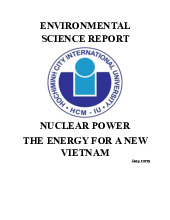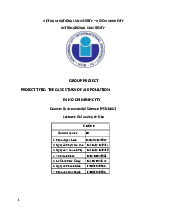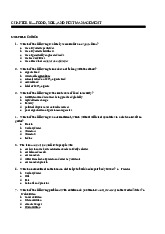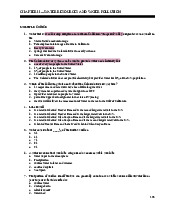



















Preview text:
School of Biotechnology, International University-HCMC Course Syllabus
Department:BioTechnology Form BT.S020
Environmental Science (PE014IU) COURSE OVERVIEW
The environment impacts all aspects of life. Therefore, it is essential that students can
understand the basic knowledge of environment and know how to conserve our environment in
the face of increasing human population growth and anthropogenic activities that degrade
natural resources and ecosystems.
Environmental science is a study of interactions among the physical, chemical and biological
components of the environment. The course topics will include all general issues; ecosystem and
biodiversity; population growth and utilization of natural resources and the environment; natural
resources and current exploitation; pollution and its impacts, environmental economic and lOMoARcPSD|47231818
School of Biotechnology, International University-HCMC Course Syllabus
Department:BioTechnology Form BT.S020
sustainable development. It also aims at increasing general awareness of the students about
possible impacts of human activities on the environment and natural resources in order to justify relevant economic practices. COURSE GOALS
(course’s goals which are corresponding with learning outcome of curriculum (X.x.x)
and qualification capacity (Know, Understand, Utilize, Analyze, Assess, Create) ) Goal Goal’s description Learning outcome Qualification (Gx) (1) (2) of curriculum capacity (4) (X.x.x) (3) G1 Knowledge-related a Know, Understand Provide essential knowledge of environmental concepts Revision: January 13, 2024 Page 2 lOMoARcPSD|472318
School of Biotechnology, International University-HCMC Course Syllabus
Department:BioTechnology Form BT.S020 through integrated technology and case studies in the context of education for sustainable development
Responsibility-related: a, c, j Raise awareness of responsibility toward others Know, Analyze, G2 in society and commit to work individually as well as Utilize, Create
collectively towards solutions of current problems and prevention of future problems lOMoARcPSD|47231818
School of Biotechnology, International University-HCMC Course Syllabus
Department:BioTechnology Form BT.S020 Use integrated online a, c Know, Analyze, G3 resources and communication tools to identify issues and Utilize, Create develop solutions
(1): Symbol of course’s goals
(2): Describe the goals with active verb, topics of learning outcome and applied situations
(3), (4): Symbol of learning outcome of curriculum and corresponding qualification
capacity assigned for the course LEARNING OUTCOMES Revision: January 13, 2024 Page 4 lOMoARcPSD|472318
School of Biotechnology, International University-HCMC Course Syllabus
Department:BioTechnology Form BT.S020
After this course, students will be able to: 1. Learning to know
Start to mingle all types of knowledge in the course content to experience construct for
sustainable lifelong welfare through:
a. Environmental and environmental science terminology and concepts; b. Population growth
c. Natural resources and current exploitation; pollution and its impacts
d. Environmental economic and sustainable development lOMoARcPSD|47231818
School of Biotechnology, International University-HCMC Course Syllabus
Department:BioTechnology Form BT.S020 2. Learning to be
Voluntarily act as an ambassador to serve the community through their self-aware and ability
to explain natural phenomenon and environmental problems caused by human activities, predict
population growth, natural resource demands, waste generations in future 3. Learning to do
Transform the theoretical content into practical actions through delivering simple sustainable
strategies to mitigate the impact of human activities on the environment and natural resource
4. Learning to live together sustainably
Spread peaceful theme to live in healthy environment through actively collaborate between
group member in group project To learn to have a minimalist lifestyle Revision: January 13, 2024 Page 6 lOMoARcPSD|472318
School of Biotechnology, International University-HCMC Course Syllabus
Department:BioTechnology Form BT.S020
5. Learning to transform oneself and society
Transform the understanding and capability for environmental quality protection, suggesting
solution for environmental problems
6. Learning to give and share
Actively share knowledge, ideas and experiences and solutions via the course projects and class
discussion addressing the environmental call and those who do not have voices and lack acknowledgment. 7. Group assignment PREREQUISITES lOMoARcPSD|47231818
School of Biotechnology, International University-HCMC Course Syllabus
Department:BioTechnology Form BT.S020 None INSTRUCTOR(S)
Assoc. Prof. Pham Thi Hoa; pthoa@@hcmiu.edu.vn RESOURCES Recommended book(s):
Miller T.G. (2005), Environmental Science: working with the earth, 14th edition, Cengage Learning
Publisher, USA. ISBN: 0495014753. On IU Blackboard
Link to course documents on BB Other Website(s) Revision: January 13, 2024 Page 8 lOMoARcPSD|472318
School of Biotechnology, International University-HCMC Course Syllabus
Department:BioTechnology Form BT.S020 COURSE ASSESSMENT
(assessment components, forms, criteria, standards, and percentage, in the
correspondence with learning outcomes of course) Assessment
Assessment form (A.x.x) Learning Percentage % component (2) outcomes of (4) (1) course (G.x.x) (3) A1. Process A1.1. Quiz/Assignment G1, G2 5 assessment A1.2. Presentation/Report G1, G2, G3 20 A1.3. Group discussion G1, G2, G3 5 A2. Midterm A2.1. Multiple choice G1 10 assessment A2.2. True/false G1 5 A2.3. G1, G2 10 lOMoARcPSD|47231818
School of Biotechnology, International University-HCMC Course Syllabus
Department:BioTechnology Form BT.S020 Completing/Matching A.2.4 Short answer G3 5 A3. Final A3.1. Multiple choice G1, G2 10 assessment A3.2. True/false G2, G3 10 A3.3. 10 G2, G3 Completing/Matching A.3.4. Short answer G2, G3 10
(1): Assessment components of course
(2): Assessment forms
(3): Learning outcomes are assessed
(4): Score percentage of assessment forms over the total score of course Revision: January 13, 2024 Page 10 lOMoARcPSD|472318
School of Biotechnology, International University-HCMC Course Syllabus
Department:BioTechnology Form BT.S020 DETAILED TEACHING PLAN
(contents in class which are corresponding with learning outcomes of course, Teaching
and learning activities (in class, at home) and assessment forms) Lecture Week/Class Content Learning Teaching and Assessment (1) (2) outcomes learning (5) of course activities (3) (4) 1
Environmental problems, 1,2,3,4,5,6 Teaching: A1.1, A2 their causes and lOMoARcPSD|47231818
School of Biotechnology, International University-HCMC Course Syllabus
Department:BioTechnology Form BT.S020 sustainability: Lecture 1.1 What are three principles of Sustainability? 1.2 How are our ecological footprints affecting the earth? 1.3 1.3 Why do we have environmental problems? 1.4 What is an environmentally sustainable society? 2
Ecosystem: What are they 1,2,3,4,5,6, Teaching: A1.1, A1.2, and how do they work? 7 Lecture A2 2.1 What keep us and other Learning in organism alive? class: Quiz & 2.2 What are the major Group components of an discussion ecosystem? 2.3 What happens to energy in an ecosystem? 2.3 What happens to matter in an ecosystem? 3
Biodiversity and Evolution 1,2,3,4,5,6, Teaching: A1.1, A1.2,
3.1 What is biodiversity and 7 Lecture A1.3, A2 why is it important? Learning in 3.2 How does the Earth’s class: Quiz & life change over time? presentation 3.3 How do geological processes and climate change affect evolution? 4
Biodiversity and Evolution 1,2,3,4,5,6, Teaching: A1.1, A1.2, 4.1 How do speciation, 7 Lecture A1.3, A2 extinction and human Learning in
activities affect biodiversity? class: Quiz & 4.2 What roles do species presentation play in ecosystems Revision: January 13, 2024 Page 12 lOMoARcPSD|47231818
School of Biotechnology, International University-HCMC Course Syllabus
Department:BioTechnology Form BT.S020 5 Biodiversity, species 1,2,3,4,5,6, Teaching: A1.1, A1.2, interactions and 7 Lecture A1.3, A2 population control Learning in 5.1 How do species interact? class: Quiz & 5.2 What limits the growth presentation of populations? 5.3 How do communities and ecosystems respond to changing environmental conditions? 6 The human population 1,2,3,4,5,6, Teaching: A1.1, A 1.2, and urbanization 7 Lecture A1.3, A2 6.1 How many people can Learning in the earth support? class: Quiz & 6.2 What factors influence presentation the size of the human population? 6.3 How does a population’s age structure affect its growth or decline? 7 The human population 1,2,3,4,5,6, Teaching: A1.1, A1.2, and urbanization 7 Lecture A1.3,A2 7.1 How can we slow human population growth? Learning in 7.2 What are the major class: Quiz & urban resource and presentation environmental problems? 7.3 How does tranportation affect urban environmental impacts? 7.4 How can city become more sustainable and livable? 8 Food, soil and pest 1,2,3,4,5,6, Teaching: A1.1, A1.2, lOMoARcPSD|47231818
School of Biotechnology, International University-HCMC Course Syllabus
Department:BioTechnology Form BT.S020 management 7 Lecture A1.3, A3 8.1 What is food security Learning in and why is it difficult to class: Quiz & attain? presentation 8.2 How is food produced? 8.3 What environmental problems arise from industrialized food production? 9 Food, soil and pest 1,2,3,4,5,6, Teaching: A1.1, A1.2, management 7 Lecture A1.3, A3 9.1 How can we protect Learning in crops from pests more class: Quiz & sustainably? presentation 9.2 How can we improve Revision: January 13, 2024 Page 14 lOMoARcPSD|47231818
School of Biotechnology, International University-HCMC Course Syllabus
Department:BioTechnology Form BT.S020 food security? 9.3 How can we produce food more sustainably? lOMoARcPSD|47231818
School of Biotechnology, International University-HCMC Course Syllabus
Department:BioTechnology Form BT.S020 10
Water resources and water 1,2,3,4,5,6, Teaching: A1.1, A1.2, pollution 7 Lecture A1.3, A3 10.1 Will we have enough Learning in usable water? class: Quiz & 10.2 How can we increase presentation fresh water supplies? 11.1 How can we use fresh water sustainably? 11.2 How can we reduce threat of flooding? 11.3 How can we deal with water pollution? Revision: January 13, 2024 Page 16 lOMoARcPSD|47231818
School of Biotechnology, International University-HCMC Course Syllabus
Department:BioTechnology Form BT.S020 11 Energy 1,2,3,4,5,6, Teaching: A1.1, A1.2, 12.1 What is net energy and 7 Lecture A1.3, A3 why is it important? 12.2 Learning in What are the advantages and class: Quiz & disadvantages of using presentation fossil fuels? 12.3 What are the advantages and disadvantages of using nuclear power? 12.4 Why is energy efficiency and important energy resource? 12.5 What are the advantages and lOMoARcPSD|47231818
School of Biotechnology, International University-HCMC Course Syllabus
Department:BioTechnology Form BT.S020 disadvantages of using renewable energy resources? 12.6 How can we make the transition to a more sustainable energy future? Revision: January 13, 2024 Page 18 lOMoARcPSD|47231818
School of Biotechnology, International University-HCMC Course Syllabus
Department:BioTechnology Form BT.S020 12 Air pollution, climate 1,2,3,4,5,6, Teaching: A1.1, A1.2, disruption, and ozone 7 Lecture A1.3, A3 depletion Learning in 13.1 What is the nature of class: Quiz & the atmosphere? presentation 13.2 What are the major air pollution problems? 13.3 How should we deal with air pollution? 13.4 How might the Earth’s climate change in the future? lOMoARcPSD|47231818
School of Biotechnology, International University-HCMC Course Syllabus
Department:BioTechnology Form BT.S020 13 Air pollution, climate 1,2,3,4,5,6, Teaching: A1.1, A1.2, disruption, and ozone 7 Lecture A1.3, A3 depletion Learning in 14.1 What are some possible class: Quiz & effects of a warmer presentation atmosphere? 14.2 What can we do to slow projected climate disruption? 14.3 How have we depleted ozone in the stratosphere and what can we do about it? 14
Environmental Economics, 1,2,3,4,5,6, Teaching: A1.1, A1.2, Revision: January 13, 2024 Page 20




